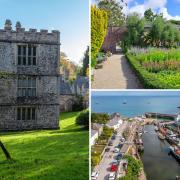Cornwall Wildlife Trust's Ventongimps Moor is favoured by lovers of wildlife, flora and fauna

Ventongimps Moor was ’s first reserve. Reserves volunteer ELLY PHILLIPS, discovers why it remains a favourite for lovers of wildlife, flora and fauna
Volunteering with the Cornwall Wildlife Trust reserves team I have the pleasure of working on a lot of different but equally beautiful reserves across the county including heathland, moorland, coastal and woodland. I am often asked which is my favourite site, a tough question, one I think I know the answer to until I revisit another reserve! So I’m going to tell you about Ventongimps Moor, the one I’ve (probably) spent the most time at and know the best.

It is the first reserve that Cornwall Wildlife Trust acquired back in the 1960s. At 20 acres, Ventongimps follows the river along the valley bottom north west of Truro. It is a mosaic of wet and dry heath with areas of bog, ponds and woodland’ (Nature Reserves Handbook), a very diverse and dynamic habitat that used to be widespread across Cornwall but is now battling to survive. It is home to the rare Dorset heath (and designated a site of specific scientific interest because of it). The large red damselfly, keeled skimmers, common blue, skippers, small heath and speckled wood butterflies are just a few of the species that I have seen. The floral list is endless, it is incredibly species rich. Being in a valley surrounded by trees it is often warmer and less windy, it is also rarely visited, therefore undisturbed and a haven for wildlife. Being there on a warm summer day the bird song is a cacophony of noise and the insect life is literally buzzing.
Like any fragile habitat it needs managing to maintain these favourable conditions. If Mother Nature had her way the pioneering birch would take over along with the gorse and willow, before you know it Ventongimps Moor would become Ventongimps Wood.

That is where the Cornwall Wildlife Trust comes in work is kept to a minimum to reduce the environmental impact but certain things are necessary. Throughout the year we have been replacing old boardwalk so visitors (and us) don’t have to wade through the bog and stick to the path so minimising the area of disturbance. Native ponies (Exmoor, Dartmoor or Shetland) are used for conservation grazing for approximately three months of the year, this keeps the purple moor grass (Molinia caerulea) from taking over, helps to regenerate the Dorset heath and other heathers and the poaching opens up grassy areas to create habitat for invertebrates and sheltered hollows for butterflies, as well as disturbing the seed bank which encourages the growth of rare plants. Some of the trees have been felled where they were marching across the moor to meet up with the trees on the other side, the relic tussocks of purple moor grass that were rediscovered have sprung back into life now they are in the open and a few plants whose seeds were in the seed bank have germinated, especially foxglove (digitalis purpurea).
Some of the birch trees have been ring barked to stop them self seeding and in the meadow Birch saplings and Gorse were removed before they reached maturity. The tree work was carried out during the winter while the trees were dormant and before the birds started their nesting to minimise disturbance. Now when we return to carry on the maintenance of the boardwalk we can see the fruits of our labour; in spring the meadow was awash with yellow flag iris (Iris pseudacorus) followed by meadowsweet (filipendula ulmaria) and now the Dorset heath is showing off its beauty across the moor.
In 1977 enthusiasts excavated a Second World War bomber from the northern end and the space left has grown to provide a valuable habitat for damsel and dragonflies.

The pond on the eastern side of the reserve is very open with only a small amount of vegetation that has colonised, this is being left to its’ own devices and will green up with time, meanwhile it is home to invertebrates and creatures that thrive in an open environment. Just inside the reserve is a seasonal pond that is well established, in spring it has lots of frog spawn and in early summer (before it dries up) this is awash with water forget-me-not (Myosotis scorpioides).
Ventongimps is lovely at any time of the year; winter time has visiting snipe (Gallinago gallinago), early spring has flowering gorse (Ulex europaes) and the first signs of life (flora and fauna), summer is just beautiful with a rich variety of flowers like purple-loosestrife (Lythrum salicaria), bog asphodel (Narthecium ossifragum), bog pimpernel (Anagallis tenella) the royal ferns (Osmunda regalis) and insects of all kinds through to autumn with the lovely reds of the bog myrtle (Myrica gale) bark and probably ponies.
When you go stick to the path (maybe admire the boardwalk a little), amble (it is only a short walk), take some binoculars and a camera, stop often, look and listen – you are in for a treat. Oh yes, and wear your wellies!
Additional reporting by Sean O’Hea, Mid-Cornwall Reserves Manager, Cornwall Wildlife Trust.


























